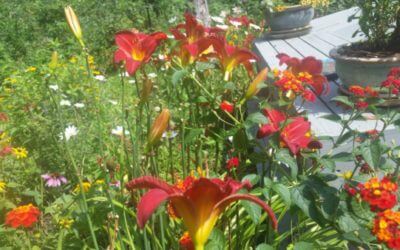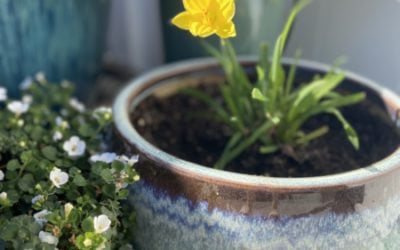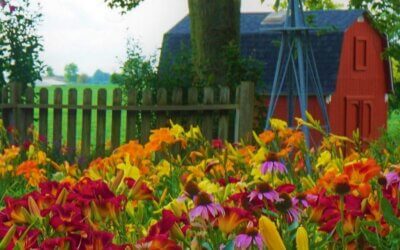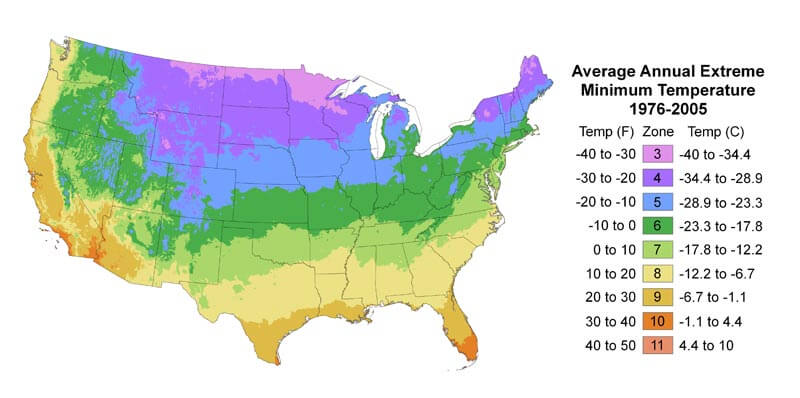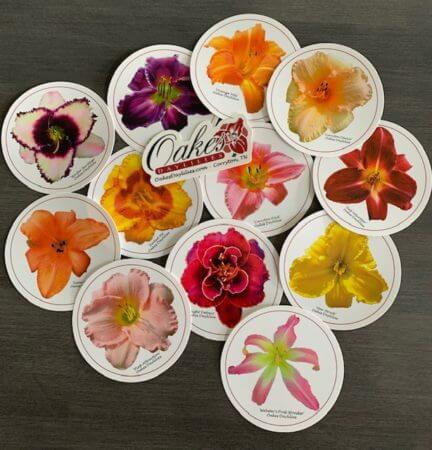If you’ve watched any of our videos about how to care for your daylilies, you may have noticed that we often talk about “watering your daylilies well.” Daylilies are drought tolerant when established but definitely benefit from consistent watering the first couple of years in your garden. If we’re being honest, daylilies appreciate a nice long drink from the garden hose even after they’ve become comfortable in your garden. We recognize that may sound like conflicting information and we also realize that “watering your daylilies well” may come off as a bit vague. In an effort to clear up some possible confusion, here’s Everything You Ever Wanted to Know About Water and Daylilies!
What Does “Water Well” Mean
Daylilies perform best when they get plenty of water. If you are unsure how much water they’re receiving naturally, like from rain, you can get a little rain gauge to put in your garden. In our videos and newsletters, we often use the phrase “make sure to water well.” But what do we mean when by that? Although there are times when they may need more (or less) water than others, a general rule of thumb is to try and make sure your daylilies get an inch or more of water a week. Ken Oakes often says that if you are watering with a garden hose, two or three good weekly soakings is going to end up being an inch or so.
When is the Best Time to Water
There are a few situations when it’s going to be more important to water than other times. For instance:
1) Planting new daylilies. You’re going to want to water your new daylilies well for a few weeks after you plant them in order to help get them established and off to a good start in your garden.
2) Daylilies in containers. Daylilies—as well as any perennials— planted in containers need to watered more often than plants in the ground. The reason is simple: plants in the ground aren’t as exposed to the elements as those in containers. They tend to dry out a lot faster than those in the ground. In the heat of the summer, you’re going to potentially want to water daylilies in containers every day.
3) It’s hot. This is common sense, but when it’s hot in your area, you’re going to need to water more often. Here in East Tennessee, we typically get nice rains through the spring. We don’t have to water a whole lot. But summer in the south is crazy. Summer comes and brings the heat and the rain usually stops—just when we need it the most. We spend a LOT of time watering in the summer!
What’s the Best Way to Water Daylilies
Between the display garden, where we hold our annual Daylily Festival, and the growing fields, where we grow and dig all the daylilies we sell, we have many, many acres here at our nursery. Watering all those fields, as you can imagine, is an important task and one that can take a good chunk of our time. Watering is important whether you have acres and acres like we do here at the farm, or a small garden at home. Some tried and true options we’ve found as the best way to water your daylilies are:
1) Irrigation. You don’t need acres and acres in order to irrigate your home garden—we know many home gardeners that choose irrigation as their favorite way to water. We have sprinkler risers in our display garden which allows us to irrigate overhead. We have a spring fed pond onsite, that allows us water access in order to irrigate in that manner. Overhead water mimics rain and is great for daylilies. If you choose to water overhead, the one thing you need to remember is to do it first thing in the morning, late in the evening or, if you have a timer, overnight. If you don’t, and choose to water just as the daylilies are starting to open up, or when they are already in full bloom, the overhead water may spot your blooms. If you get spotted blooms that day, there’s not need to stress—the new ones the next day will bloom out just fine.
2) Classic Garden Hose. Although we have an irrigation system set up at the nursery, at home I use my good old-fashioned garden hose. I attach a wand to the end of the garden hose and enjoy time spent in the garden watering my daylilies, shrubs and other flowers and perennials. I find it relaxing. If you’re watering with a hose and a wand, you can do so whenever you have time. Just water around the foliage at the base of the plant and you won’t have to worry about getting water on the blooms. A good two to three soakings a week is all it takes for beautiful daylilies!
3) Use a Soaker Hose. Your third option would be a soaker hose. A soaker hose is a fantastic option for those of you who live in areas with water restrictions and is the most efficient way to apply water no matter where you live. One thing: it can be quite difficult to measure exactly how much water you are actually putting out. A good rule of thumb when using a soaker hose is to just make sure the soil is moist around your daylilies.
How Much is Too Much?
We’ve talked about watering your daylilies, but how much is too much? Daylilies don’t like mushy feet for extended periods of time. If you live in an area that gets standing water a couple of times a year and then soaks in after a few days, no worries! That’s typically not going to harm your daylilies. However, if you have daylilies planted in an area that stays consistently wet, moving them to a drier part of your garden would be a good decision.
What if Daylilies Don’t Get Enough Water?
We had a customer comment on one of our videos recently saying something along the lines of “hey, I see you mentioned water well a lot in your videos and I really don’t water my daylilies at all and they look great.” We say one of the great things about daylilies is, if they’re established, they are pretty drought hardy and tolerant. If you can’t give them consistent water, they may look fine, but they may not have as many blooms as they would with regular watering. The blooms they do have probably won’t be as big as they should be. They may not grow as tall as they should or have their bloom season last as long. In general, they just won’t look as good as they would if they had plenty of consistent water.
Water and Rebloom
Rebloom is a hot topic with daylilies. Some daylilies—but not all!— will bloom and then bloom again. Of the reblooming varieties, some rebloom more than others. If a daylily in your garden is a reblooming variety, water is going to be a major factor for successful rebloom. A quick word about rebloom: as I mentioned, rebloom is something that some daylily varieties do and others don’t. If a daylily is a reblooming variety, that trait is listed with each daylily on our website. Some daylilies rebloom more prolifically than others. We call those Our Top 20 Rebloomers and have a separate category just for them on our website, too. Rebloom is a great trait in a daylily, but is somewhat restrictive in the colors and shapes that are available. We typically suggest you don’t choose a daylily based on whether it reblooms or not: Plant what you love!
Daylilies are tough plants. They’re easy to grow, hardy perennials and they’re going to be able to tolerate dry conditions. BUT— like most perennials, they’re going to look their best if you can give them plenty of water. An inch or more a week is really all it takes to have a beautiful garden.
Visit our YouTube channel and watch this video on Water and Daylilies.


